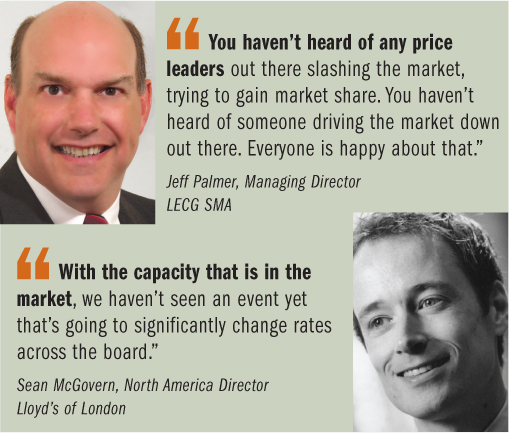A spate of disasters early this year, the ongoing oil spill in the Gulf of Mexico and predictions of an active hurricane season have reinsurers on edge. But with capacity still relatively high, the U.S. reinsurance market remains soft and is well capitalized for the challenges ahead, according to experts in the field.
“The lament is everywhere, whether you talk to brokers or carriers–there's too much capacity,” Hank Watkins, president of Lloyd's America, told National Underwriter. And as far as any indications of a hardening in the market, “there hasn't been a cataclysmic event that would suggest that coming any time soon,” he added.
 “The industry is pretty well capitalized,” according to Sean McGovern, director for North America and general counsel at Lloyd's, who observed that reserves are strong and investments are better than expected.
“The industry is pretty well capitalized,” according to Sean McGovern, director for North America and general counsel at Lloyd's, who observed that reserves are strong and investments are better than expected.
“We went into this year thinking there wouldn't be anything in terms of investment return, but actually the market as a whole has been fairly strong, compared to where we thought it would be,” he said.
“We're all holding our breath, but the Central Fund at Lloyd's has never been any bigger–?2.6 billion,” or $3.89 billion at current exchange rates, he noted, referring to the fund that guarantees payment to those buying coverage through the Lloyd's market if a syndicate should fail.
In January, he recalled, “we had a big European windstorm–Xynthia–and the Chile [earthquake] loss, where Lloyd's issued [an insured loss] figure of $1.4 billion.”
However, he added, “with the capacity that is in the market, we haven't seen an event yet that's going to significantly change rates across the board.”
Overall, according to Mr. McGovern, rates are down or flat, other than in segments such as the energy market, “where quite frankly they needed to harden significantly, because that's a market that's struggled to make money over the long haul.”
In fact, he said energy rates are expected to rise about 50 percent, thanks in large part to fallout from the the BP spill. “As recently as April we didn't see much change, but we're seeing it now,” he added.
Mr. McGovern said that in many ways, the oil industry and energy underwriters have had “a close shave in the sense that BP is largely self-insured.” If the Gulf spill had involved another operator besides BP, he noted, “this would have been a very significant loss to the energy market.”
“What we're hoping for is that the platform operators, the oil companies, and the insureds and reinsurers will heed that fact–that they've had a near-miss here that could have been a catastrophic loss for the industry,” Mr. McGovern said. “It will be more manageable because of BP's self-insurance.”
The fact that BP is self-insured, he added, doesn't mean there will be no “leakage into the [insurance] market through liability claims, but I think the industry has had a near-miss.”
Jeff Palmer, a managing director of LECG SMART at the firm's global headquarters in Devon, Pa., observed that “most people think it will be like a [directors and officers] type of situation for BP, as far as what are the insured losses. That will be interesting.”
Just how the presence of oil in the Gulf might impact insured losses following a hurricane is another wild card in the market, he warned. “It could be a sticky mess, not necessarily a contamination problem.”
He recalled that when Hurricane Andrew struck Florida, a power plant was hit and their biggest cost was an oil drum that was punctured, causing oil to be blown everywhere.
“It took a lot of time to clean that up. It was time and effort as opposed to any hazardous material,” Mr. Palmer concluded.
As for the reinsurance market overall, however, “the biggest word I get is that it's relatively quiet out there right now,” he said. “Capacity is not an issue–there's plenty of capital in the markets.”
That excess capacity, Mr. Palmer added, has resulted in price reductions over the last couple of renewals.
“Depending on the line of business, most people are talking 5 percent to 10 percent,” he said. “Most people are not saying it's a softening market–they're saying it's a reaction to conditions back in 2008 and 2009 with the financial crisis.”
Because of the collapse of the housing and banking markets, sending the United States and some European countries into a deep, persistent economic retraction, he said, “all the carriers took a big hit, and they tried to protect themselves because their capital was going down. So they are going back to [capital] levels prior to that.”
“I think everyone is being cautious,” Mr. Palmer said. “It's not a response where people are chasing the market. It's more of a measured response.”
Because there is plenty of capital available to insurers, “they are offering price reductions, but they are not cutting to the bone,” according to Mr. Palmer.
While some would say price reductions of 5 percent to 10 percent indicate a soft market, many are seeing it as a “status quo market,” he said. “If you have a good program, you can get some reductions, but the only place you are seeing increases is in very targeted books of business where they have been traditionally bad performers.”
Presently, Mr. Palmer said, the market could be described as “very quiet and calm. They're taking a breath after all that happened with the financial things.”
But even with the financial debacle that drained insurers' capital, he added, “they were able to recover quite nicely with the investments. So their assets recovered quite nicely and it was also accompanied by a very low catastrophe year. The combination of those two things let everybody recover fairly well.”
At the moment, reinsurers have “some capital, and there's still plenty out there, so we have to make sure we watch the capital that's flowing into the market and make sure we keep our share of the market,” he said.
Mr. Palmer also noted that people are trying to price appropriately, pointing out that “this is always a difficult endeavor. They want to get the right price but make sure they hold onto their current book of business.”
He emphasized that “you haven't heard of any price leaders out there slashing the market, trying to gain market share. You haven't heard of someone driving the market down out there. Everyone is happy about that.”
Beyond the BP oil spill, the first quarter saw a number of large natural catastrophes, which did hit some reinsurers, “and the forecasts for hurricane seasons are quite dire at this point, so we'll see what happens,” he said.
Mr. Watkins cited a trend continuing from 2009, which is broker consolidation–especially on the wholesale side.
This trend, he said, is continuing mostly because of retailers “who run their own agency or firm. They're waiting for that hard market to come and lift the valuation, but they don't see it coming.”
The environment for brokers globally is tough, Mr. McGovern added. “It's a hugely competitive market and the brokers, frankly, are killing each other to win business. We're seeing consolidation in London as well.”
He pointed out the opportunity in the United States to educate brokers who haven't historically dealt with Lloyd's on what the market can offer them and how they can access the market.
Mr. Watkins noted that in the current soft market, “a number of the standard carriers have come into the formerly surplus lines space and taken a bite out of that.” To reach brokers, Lloyd's is offering webinars and other online events through broker and surplus lines organizations.
RELATED CHART:
Year-End Policyholders Surplus For Top Reinsurers
Want to continue reading?
Become a Free PropertyCasualty360 Digital Reader
Your access to unlimited PropertyCasualty360 content isn’t changing.
Once you are an ALM digital member, you’ll receive:
- Breaking insurance news and analysis, on-site and via our newsletters and custom alerts
- Weekly Insurance Speak podcast featuring exclusive interviews with industry leaders
- Educational webcasts, white papers, and ebooks from industry thought leaders
- Critical converage of the employee benefits and financial advisory markets on our other ALM sites, BenefitsPRO and ThinkAdvisor
Already have an account? Sign In Now
© 2025 ALM Global, LLC, All Rights Reserved. Request academic re-use from www.copyright.com. All other uses, submit a request to [email protected]. For more information visit Asset & Logo Licensing.








